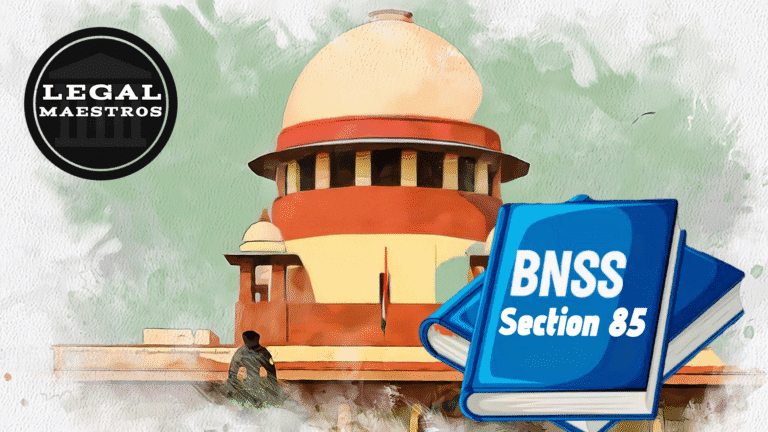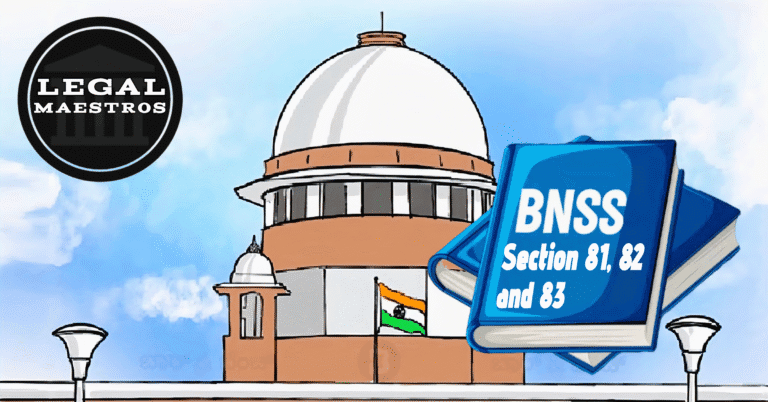
Section 63: Form of Summons
The statutory elements that must be met in order for a court to issue a summons are outlined in Section 63 of the Bharatiya Nagarik Suraksha Sanhita to be published in 2023. A summons is a legal notice that requires a person or representative of an entity to appear before a court of law. It is issued by the administration of justice.
Every single summons must be either of the following, as stated in this section:
In Writing and in Duplicate Form: The summons must be written down, made in duplicate copies, and signed by the officer who is presiding over the court. Nevertheless, the summons may be signed by an officer who has been authorized by the High Court through the rules in certain circumstances. Additionally, the court’s seal must be affixed to the summons in order to guarantee that it is genuine.
For any queries or to publish an article or post or advertisement on our platform, do call at +91 6377460764 or email us at contact@legalmaestros.com.
In Electronic Form: The Sanhita acknowledges the necessity of modernization and, as a result, permits the issuance of summonses in both encrypted and other modes of electronic communication. Additionally, in order to preserve their legal validity, these must also bear the image of the court’s seal.
Consider the following scenario: a court sends a summons to Mr. A, requesting that he attend in a case. The summons may be a tangible document that has the seal of the court and the signature of the judge, or it may be an encrypted PDF document that is sent through a secure court email and displays a scanned image of the court seal. In a legal sense, both formulations are suitable.
Section 64: Summons How Served
Immediately following the issuance of a summons, the method for serving it is outlined in Section 64. Who is permitted to serve the summons, how the service must be carried out, and what must be recorded are all topics that are covered in this document.
For any queries or to publish an article or post or advertisement on our platform, do call at +91 6377460764 or email us at contact@legalmaestros.com.
Persons Authorized to Serve Summons is the subject of the first subsection.
In accordance with the law, a summons may be served by a law enforcement officer, or, in accordance with certain regulations established by the State Government, by an officer of the court that issued the summons or any other public servant.
In addition to this, it requires that a comprehensive register be kept or maintained by the registrar of the court or each police station. In accordance with the regulations set forth by the State Government, this register ought to contain the recipient’s addresses, email addresses, phone numbers, and any other pertinent information.
An example of this would be a police officer delivering a summons to Mr. B in the event that he is taken to court. Additionally, the officer makes certain that Mr. B’s address, phone number, and email address are recorded in the register. In the future, this will be helpful for accountability and follow-ups.
For any queries or to publish an article or post or advertisement on our platform, do call at +91 6377460764 or email us at contact@legalmaestros.com.
Chapter Two, Section Two: The Mode of Serving
Personalized service is the mode that is most preferred. To the greatest extent possible, the summons need to be sent directly to the individual. The person receives one of the two copies that have been supplied or tendered to them.
It is also possible to provide electronic service under this subsection. In the event that the summons bears an image of the court seal, it is possible to serve it using electronic means, such as email, messaging platforms, or other digital systems, provided that these methods adhere to the rules that have been established by the California State Government.
For example, if Mr. C is difficult to locate physically, the court may send him an electronic version of the summons that has been digitally signed and includes an image of the court’s seal, as is permitted by the local regulations. In the event that the email log is used as proof of delivery.
For any queries or to publish an article or post or advertisement on our platform, do call at +91 6377460764 or email us at contact@legalmaestros.com.
Receipt Acknowledgment is provided in the third subsection.
In the event that a summons is served personally, the individual who is receiving it is obligated to sign a receipt that is located on the reverse side of the duplicate copy if the officer who is issuing the summons requests it. In the event that the summons was successfully served, this receipt, which has been signed, serves as proof.
The illustration shows that Mr. D is served with a summons by a law enforcement official. He is requested to sign the duplicate copy of the document. This signed duplicate is returned to the officer, who then files it away as evidence that the service was performed.
Section 65: Service of Summons on Corporate Bodies, Firms, and Societies
The manner in which summonses are to be served on organizations and other non-individual entities, such as corporations, enterprises, and societies, is subject to the provisions of Section 65.
For any queries or to publish an article or post or advertisement on our platform, do call at +91 6377460764 or email us at contact@legalmaestros.com.
Companies and corporations are subject to the provisions of subsection (1).
All officers of the firm or corporation, including the Director, Manager, or Secretary, are eligible to receive summonses if they are called upon to appear. Either in person or by sending a registered letter addressed to one of these officers, this can be accomplished using either method.
At the point in time when the letter would ordinarily arrive through conventional postal delivery, the service is considered to have been completed lawfully when it is sent through registered mail.
In this section, it is made clear that the term “company” can apply to any body corporate, and that the term “corporation” include both incorporated corporations and societies that are registered under the Societies Registration Act, 1860.
For any queries or to publish an article or post or advertisement on our platform, do call at +91 6377460764 or email us at contact@legalmaestros.com.
Example: [Figure] Let’s say that a firm gets accused of anything in a civil case. A summons is issued by the court to the Managing Director of the corporation and is sent through registered mail. Within a period of three business days, the mail is delivered. However, regardless of whether or not the Director acknowledges it, the law considers it to be legal service on the day that was anticipated for delivery.
(2) Service on Firms and Associations is the subject of this subsection.
As is the case with corporations, a summons to a company or group of individuals can be served on any of the partners in the company or organization. Postal service is another option for accomplishing this. As stated previously, the service is regarded to be finished when it is anticipated that the letter will be delivered by the postal system.
A partnership firm known as “XYZ Traders” is called upon to provide an illustration. The summons is delivered to Partner E by the court through the use of registered mail. According to the predictions of the postal service, it will be delivered in two days. In the event that Partner E does not pick it up, the court will consider it to have been served after those two days have passed.
For any queries or to publish an article or post or advertisement on our platform, do call at +91 6377460764 or email us at contact@legalmaestros.com.




![JOB POST: Junior Associate at ASM Law Chambers, Jaipur [Freshers]](https://legalmaestros.com/wp-content/uploads/2025/11/Gemini_Generated_Image_8wrxer8wrxer8wrx-768x708.png)


